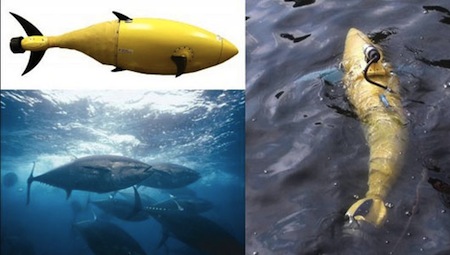It's not clear how many of those robots police operate, and law enforcement isn't by any means the only domestic market for the 'bots. But the trend lines point toward more robotic spy tools for law enforcement in more places -- with more DHS cash.
Here are five examples.
Predator B - Unarmed Predator surveillance drones inside the United States have had a rocky history. The Department of Homeland Security's sub-agency, U.S. Customs and Border Protection (CBP), has flown them off-and-on along the U.S.-Mexico border since 2004. But in the years to come, the Predator is likely to have a numerically more marginal role as more law enforcement agencies join the drone bandwagon -- it's exceedingly likely the Predator will remain an exclusive item for the federal government. That is, a federal government putting the machines to work snooping on domestic turf.
BIOSwimmer - Catch it if you can. In September, the Department of Homeland Security's Science and Technology Directorate premiered a prototype of its tuna-shaped robot called BIOSwimmer, developed by Boston Engineering Corporation. The concept revolves around eventually deploying the swimming robot to use in port security operations, and could prove to have several advantages over human divers.
For one, it can get into tighter spaces, and can work in areas that have been contaminated with oil or other hazardous chemicals that could pose a risk to human health. But mainly, it's designed to inspect ships and "flooded bilges and tanks, and hard to reach areas such as steerage, propulsion and sea chests," noted a DHS statement.
ShadowHawk - In a way, the trials of the ShadowHawk represent why police drones remain limited, at least for the time being. The Department of Homeland Security handed $220,000 to the Montgomery County Sheriff's Department -- just north of Houston, Texas -- for one of these 50-pound helicopter drones in 2011.
For surveillance, it can be equipped with a Sony FCB EX-1020 camera or a Photon 320 thermal imaging camera, and in theory would've allowed the county's law enforcement to cease relying on over-worked and tight-budgeted agencies in Houston for aircraft.
Versatrax 150 - The past decade has seen a big build-up in border security under Homeland Security's watch, including a doubling of Border Patrol agents and hundreds of miles of fence along the U.S.-Mexico border. But to keep their wares flowing, the drug cartels in Mexico have turned to an inventive tactic: digging more and more tunnels deep underground.
A high-resolution camera can rotate in all directions, and the robot itself can squeeze through an opening as small as six inches in diameter. Border tunnels can also be dangerous places, at the risk of collapse and even booby-trapped -- with no telling who's inside or what weapons they may be carrying. The Versatrax was designed for sludging its way through sewer tunnels, so it's not that big of a leap.
Draganflyer X6 - The Draganflyer X6 mini-helicopter is perhaps the first police drone to see regular active use inside the United States by a local police agency. In July 2010, the Mesa County Sheriff's Office in western Colorado used funding from the Department of Homeland Security to buy one of the machines, while also becoming one of the first police agencies for the FAA to authorize using the drones for police work.
The drone packs either a Panasonic DMC-ZS20 camera or an infra-red thermal imaging camera, and can transmit video (when it's not recording) in real-time back to an operator. The camera is stabilized against vibration, and a sensor head made of carbon fiber contains the gyros, accelerometers, GPS receiver and a barometric pressure sensor to keep it in the air.












